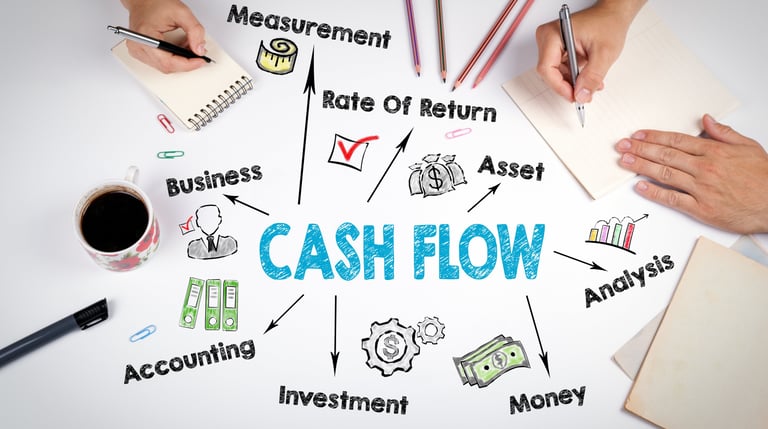Business Cash Flow vs. Profit: The Simple Guide (for Solo Founders)
Learn the real difference between cash flow and profit — and how a simple weekly review can save your business from financial stress.
10/19/20255 min read


The Day I Realized “Profit” Doesn’t Mean Safe
I still remember the day I opened my bank app and froze. The balance was almost zero.
A few days earlier, I had proudly told my friend, “We’re finally profitable this month.” But standing there, staring at that tiny number on the screen, it didn’t feel like profit at all — it felt like panic.
I was selling, invoicing, and even showing profit on paper. But the cash just… wasn’t there. The numbers told one story, while my bank account told another.
That’s when I learned a hard truth every founder eventually faces:
👉 Profit is not the same as cash flow.
If you’ve ever felt this too — that strange disconnect between your income statement and your actual money — this post is for you.
Today, I’ll break down the difference between profit and cash flow, the traps that keep founders stuck, and the simple weekly system I use to keep my finances crystal clear.
And if you’re ready to dig even deeper, grab my free guide — 10 Money Mistakes That Are Keeping You Broke. It’s a short but powerful read that’ll help you avoid the financial blind spots most small business owners don’t see coming.
1. Cash Flow vs. Profit: The Simple Truth
Let’s keep this simple.
Profit is what’s left after you subtract all your expenses from your revenue.
Cash flow is the actual movement of money in and out of your business.
You can be profitable and still run out of cash.
You can have strong sales but still feel broke.
You can even owe taxes on money you haven’t received yet.
Why? Because profit is theoretical. Cash flow is survival.
Profit tells you how your business performs on paper.
Cash flow tells you whether your business can actually breathe.
Think of it this way:
Profit is your fitness tracker saying you “should be healthy.”
Cash flow is whether you can actually climb the stairs without gasping for air.
A profitable business can collapse if it runs out of cash. But a business with healthy cash flow can survive even through unprofitable months.
2. The Hidden Traps Founders Fall Into
When I started Focus & Conquer, I made every classic mistake. I thought that because I was generating revenue and had low expenses, I was doing fine. But these are the most common traps that quietly drain your cash:
Trap #1: Counting Invoices as Income
You celebrate a sale, send the invoice, and immediately feel richer. But until that invoice is paid, that money isn’t yours.
Unpaid invoices are one of the biggest silent killers of small business cash flow.
Trap #2: Paying Yourself Last
I used to tell myself, “I’ll pay myself when things stabilize.”
They never really do — unless you plan for it. Paying yourself last often leads to resentment, burnout, and confusion about whether your business is actually sustainable.
Trap #3: Ignoring Seasonality
Many solopreneurs don’t account for the natural ups and downs of their business cycle. When revenue dips, panic sets in. When it spikes, spending goes wild.
A predictable system smooths those extremes.
Trap #4: Mistaking Bank Balance for Financial Health
Your balance isn’t your profit.
It’s a mix of money that might be needed for taxes, upcoming expenses, or future obligations. Treating your bank balance as available profit leads to overconfidence — and quick depletion.
Trap #5: Not Reviewing Finances Weekly
This is the habit that changed everything for me.
When you wait until month-end (or worse, tax season) to “see how things went,” you lose control of your story. A short weekly check-in can prevent 90% of cash flow surprises.
3. My 3-Step Weekly Cash Review System
This is the rhythm that keeps my finances grounded. I do it every Friday morning with a cup of coffee, before diving into work. It takes about 15 minutes — but it completely changed how I run my business.
Step 1: Track Every Inflow and Outflow
Open your accounts. Check what’s actually moved — not what’s been invoiced, not what’s “scheduled.”
Note every transaction: what came in, what went out, and what’s pending.
💡 Tip: Use the Finance Clarity Tracker to see it visually. It separates income and expenses— so you know exactly where you stand.
Step 2: Forecast the Next 14 Days
List expected payments, bills, subscriptions, and transfers.
Ask yourself: “If every client pays late, can I still cover my essentials?”
If not, plan now — not later. Adjust your spending or chase pending payments before it becomes a crisis.
Step 3: Reconcile and Reflect
This is the grounding part.
Compare your expectations (planned cash flow) to what actually happened.
Where were you off? Where did money leak?
Sometimes the biggest lesson isn’t in the numbers, but in your habits — overspending, underpricing, or avoiding follow-ups.
This simple review gives you real-time clarity. No more waiting for “the end of the month” to discover you’re short.
4. A Real Example: When I Almost Burned Out My Business
Last year, I had a month that looked perfect on paper.
Revenue: up.
Expenses: low.
Profit margin: great.
But then, one of my biggest clients delayed payment for two weeks. Another recurring expense hit sooner than expected. Within days, I was juggling bills, feeling like I had failed at something I supposedly “understood.”
That’s when I built my own system — the same one that later became the Finance Clarity Tracker.
Instead of reacting to my bank balance, I started tracking my cash flow every week. I built small buffers, separated tax money automatically, and learned to forecast slow months before they happened.
Within three months, the difference was night and day.
For the first time, I wasn’t guessing — I was leading.
And the peace of mind that came from that? Priceless.
5. Action Plan — Your 15-Minute Cash Flow Routine
Let’s make this practical. Here’s how you can start this week:
Pick your review day. Friday works best — it closes the week cleanly.
Open all accounts. Business checking, credit cards, PayPal, anything connected to cash flow.
List your inflows and outflows. Use a spreadsheet or a tracker (like Finance Clarity Tracker).
Compare plan vs. reality. Where did money move differently than you expected?
Forecast 14 days ahead. Look at upcoming invoices, bills, and taxes.
Set aside for taxes. Even a small percentage helps build discipline.
Write one sentence of reflection. Something like: “This week, I felt more in control because I tracked everything.”
Consistency beats perfection here. The point isn’t to predict every detail — it’s to stay aware and responsive.
6. Reflection — Why This Matters More Than You Think
Understanding cash flow isn’t just about spreadsheets or money management.
It’s about trusting yourself as a business owner.
When you know exactly what’s coming in and going out, you stop making fear-based decisions. You stop chasing quick fixes. You stop undercharging.
You start building from a place of clarity, not chaos.
So next time someone brags about their “profit,” remember this:
Profit is potential.
Cash flow is power.
And the best part? You don’t need to be a financial expert to master it — you just need a system that works for you.
Ready to Take Control of Your Money?
Start by fixing the most common money mistakes entrepreneurs make.
👉 Download the free guide — “10 Money Mistakes That Are Keeping You Broke.”
And if you’re ready to take it further, organize your cash flow, track your goals, and finally see where your business stands —
👉 Get the Finance Clarity Tracker.
